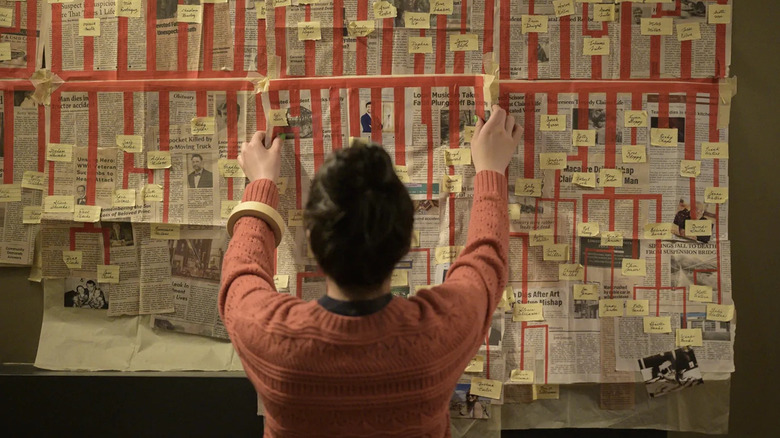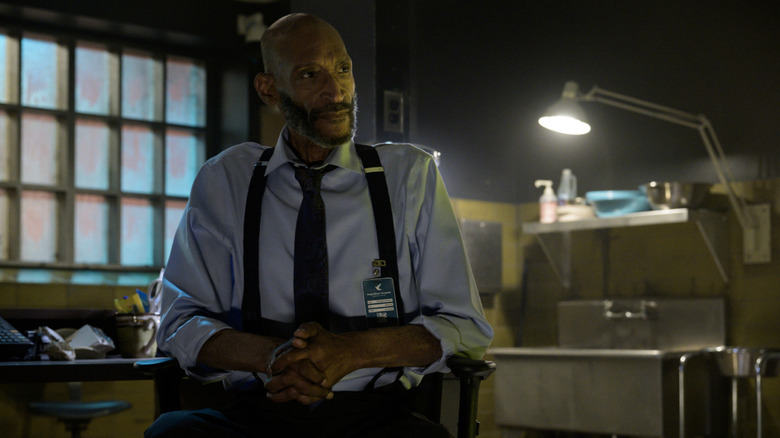Final Destination Bloodlines Finally Explains The Franchise's Entire Universe
This article contains spoilers for the "Final Destination" franchise, including "Bloodlines."
One of the highlights of 2000's "Final Destination" is how Glen Morgan and James Wong reconfigured Jeffrey Reddick's premise about a boy helping himself and others escape their fate after having a premonition of a deadly airplane accident into a slasher film where the killer is literally Death. Not only did this mean that Death was never personified or ever really seen in the movie, but it also allowed for Morgan and Wong (the latter also being the director) to present each kill scene as a series of escalating mishaps and accidents, essentially turning each setpiece into a Rube Goldberg-esque machine of mayhem. When "Final Destination 2" was made just a few years later, the filmmakers could've simply written a sequel that repeated the premise of the first film, and ostensibly, they did. It's a formula that would work, as proven by "Final Destination 3" and "The Final Destination," two movies which have no connection to each other or the prior installments beyond the basic premise and some indication that they all take place in the same universe.
However, the "Final Destination 2" filmmakers added a clever wrinkle to their sequel: not only did it involve another fatal accident which a few select people survive due to a premonition that causes them to be stalked by Death, it also explained how each of the survivors of their accident had already avoided death before, thanks to the survivors of Flight 180 from the first film. Thus, if Flight 180 had killed everyone on board as originally intended by Death, then the survivors of the road accident pile-up would never have been present at that accident, let alone survived it. The twist began to tie the entire "Final Destination" franchise together, a notion which was only mentioned in passing during "Final Destination 3." This concept seemed to be paid lip service to by the clever ending of "Final Destination 5," which revealed that the survivors of that movie became two of the doomed passengers of Flight 180, making "5" a secret prequel to the first film.
Now, the latest installment of the franchise, "Final Destination Bloodlines," has seemingly brought back the concept, albeit in a subtler fashion. While there isn't a moment in "Bloodlines" that's akin to the scenes in "2" and "5" in terms of connecting the series, there is a heavily implied connection between the events of "Bloodlines" and the entire franchise, meaning that the story of "Final Destination" may be one large Rube Goldberg machine itself.
The consequences of the 1969 Skyview disaster
The "Final Destination" series has seemingly adopted the implicit idea that certain people can have premonitions of their death, and that if they choose to alter those events, Death will attempt to come after them (and, in most cases, succeed). While the events of the first two "Final Destination" films and "Final Destination 5" are related, the series has so far established that a relationship to a person who may or may not have survived Death before is not a prerequisite for Death to become interested in someone. Yet "Bloodlines" changes all of this, in a way that's both audaciously bold and impressively subtle.
In "Bloodlines," we're shown the earliest instance of a premonition and an averted disaster ever depicted in the series. In 1969, the Skyview Restaurant celebrated its grand opening ahead of schedule, a fact that the staff were too happy to crow about. Iris (Brec Bassinger) is taken to the Skyview on a date by her steady beau, Paul Campbell (Max Lloyd-Jones), and all of the troubling omens of doom that Iris picks up on are dismissed by her as side effects of her new pregnancy. However, after Iris experiences a premonition depicting the violent deaths of just about everyone attending the Skyview opening, she's able to warn the guests and avert a massive tragedy. Right away, this marks a departure for the franchise, for where prior Cassandra figures in the series have only been able to convince a few other people to join them in leaving the future site of doom, Iris manages to save hundreds of lives.
As Iris' granddaughter, Stefani (Kaitlyn Santa Juana), and the rest of her extended family discover to their horror, this means that Death was robbed of hundreds of promised lives that fateful day, and all of the subsequent descendants of the people not killed at the Skyview disaster are people who, according to Death, were never meant to exist. This sets in motion the main plot of "Bloodlines," revealing that Death is looking to wipe Iris' family out of existence. Fortunately, thanks to the copious amount of notes and research that a death-crazed Iris gathered over her lifetime, it's implied that numerous other people are similarly affected. At one point, a Post-it note with the year "2000" is seen on Iris and Stefani's timeline breakdown. That's right: "Bloodlines" infers that every single "Final Destination" movie is the result of the aversion of the Skyview disaster, and that the whole franchise is one big domino chain of Death's victims.
The secret history of William Bludworth
This unified theory of "Final Destination" isn't just there to help explain how and why the past films' characters have premonitions of death, why they're targeted in the first place, and so on. It also provides a clever explanation for one of the other longest-running mysteries of the series, namely the backstory of William Bludworth (Tony Todd). Ever since his appearance in the first "Final Destination," Bludworth has appeared to be highly knowledgeable about Death, its various rules, patterns, and how someone hunted by Death may escape their fate. With each successive appearance, speculation from fans about Bludworth's origins grew, especially as he seemed to be the only authority around on Death. Although depicted as a coroner who owned some funeral homes, some people started to theorize that Bludworth might somehow be connected with Death, either as an angel, a devil, or as a physical manifestation of the force itself.
Given that Todd, who passed away in November of last year, was adamant that he appear in "Bloodlines" to give the character a proper send-off, it's no surprise that the film takes the opportunity to clarify who Bludworth is and how he came to know so much. It turns out that William was also present at the Skyview Restaurant in 1969, the child of a woman performing at the grand opening event. Iris' actions saved his life. Thus, Bludworth and Iris struck up a lifelong friendship while they both tried to avoid Death by studying it closely, the two of them sharing information and tips along the way. Sadly, both Bludworth and Iris were so successful that they nearly simultaneously contracted cancer, which was the last resort of Death in its long quest to claim them. Although Iris' demise is hastened by other circumstances as she sacrifices herself to prove the threat of Death is real to Stefani, it's implied that Bludworth will succumb to his illness.
Perhaps the most impressive aspect of this overarching explanation of the franchise that "Bloodlines" presents is that it isn't shoved in the audience's face. In other words, this isn't an instance of "Bloodlines" trying to trade on nostalgia by directly referencing all the previous films, but is instead a cool concept that's there if you want it. The explanation is satisfying enough that the series could use "Bloodlines" as a culminating chapter, or it could use it as a springboard for several more sequels to follow. If the "Final Destination" series has as much gas left in the tank as "Bloodlines" promises, then I hope the latter is the case.


